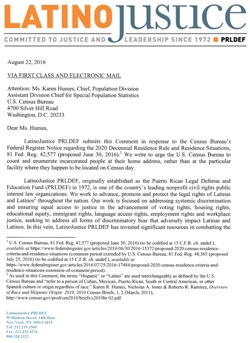LatinoJustice Urges Changes in How Census Bureau Counts Incarcerated People
Expressing concern for how communities of color are impacted by the Census Bureau's residence rules, LatinoJusticePRLDEF calls for a change in how incarcerated people are counted.
by Alison Walsh, August 23, 2016
We received the following press release from our friends at LatinoJustice PRLDEF. Learn why they are calling on the Census Bureau to count incarcerated people at home in 2020:
FOR IMMEDIATE RELEASE: August 23, 2016
Contact:
John Garcia, Director of Communications (LatinoJustice PRLDEF)
(212) 739-7513, (917) 673-9095 or jgarcia [at] latinojustice.org
New York, NY — The U.S. Census should count prisoners at their home addresses, where they have the strongest family and community ties, and not where they are incarcerated, LatinoJustice PRLDEF said in a letter to the U.S. Census Bureau. Earlier in June of this year, the Bureau announced its decision to continue the practice of counting incarcerated people where they are detained, rather than in the communities they call home, for the 2020 Census. Before the rule becomes final, the Bureau is giving the public, organizations and individuals a chance to send in comments.
LatinoJustice PRLDEF is concerned with how Latinas, Latinos, and other communities of color may be impacted by this residence rule. In addition to being illogical and inconsistent, the proposed rule creates a high risk of vote dilution through prison gerrymandering and reinforces systemic racial inequality, LatinoJustice attorneys wrote the Bureau.
Juan Cartagena, LatinoJustice PRLDEF President and General Counsel, has followed this issue for many years.
“In a time when many underprivileged and unjustly marginalized people of color are forced to keep reiterating that their lives matter, importing the myriad problems and statistically-proven racial discrimination of the criminal justice system into the calculus of political power and representation only further entrenches systemic racial inequity, which is an untenable proposition for the American people in 2020,” he said. “We believe the U.S. Census can and should do better. No incarcerated person’s family and community ties should be valued any less than a boarding school student’s family and community ties. To do so is the definition of inequality.
LatinoJustice PRLDEF Associate Counsel Joanna Cuevas Ingram drew a comparison with members of Congress who, like those who may be incarcerated, are serving a time-limited term and are likely to return home.
“No one doubts that a Congress member’s usual residence is in his or her home district,” Cuevas Ingram said. “Incarcerated people should be afforded the same presumption, as they are just as likely to return home to where they have the most family and community ties.”
More privileged populations are counted in a way that recognizes their connections to their true homes and communities. This glaring inconsistency raises concerns about whether the Bureau places less value on the lives, families, and communities of incarcerated people, who are disproportionately Black and Latino.
The Bureau counts incarcerated people wherever they happen to be detained on Census day because, presumably, that is where they live and sleep “most of the time.” But this is simply not true.
For example, in one 2008 study in New York, the median time that an incarcerated individual remained at a particular facility was only 7.1 months. In Georgia, the median is only nine months. When people are moving from facility to facility at irregular and frequent rates, it does not make logical sense to count their “usual residence” as the place where they happen to be located on one particular day, especially since most incarcerated people are serving short sentences and will return to their home communities.
The inconsistency of the Bureau’s residence rules is clear in its treatment of boarding school students in comparison with incarcerated people. Boarding school students are counted at their home addresses, even though they live and sleep most of the time at school.
One of the Bureau’s justifications for counting these students at home is the “likelihood” that they will return home when they stop attending school. But most U.S. boarding schools have almost universal college attendance rates upon graduation. In fact, every one of the fifteen schools that board more than 400 students reports a college attendance rate upon graduation of either 99% or 100%. Such high college attendance rates are completely inconsistent with the Bureau’s reasoning of the “likelihood” that these students will return home after attending boarding school.
This inconsistency in the Residence Rules is particularly troubling given the racial and economic disparities at work. Both boarding school students and members of Congress tend to be much whiter and wealthier overall than people who are incarcerated.
“What these comparisons show is a tendency—however unintentional—to treat racially and economically privileged populations differently from low-income communities of color that are harmed by prison gerrymandering,” said Rebecca Ramaswamy, a LatinoJustice Legal Fellow who has followed this issue closely. “The Bureau needs to be conscious of that disparity, especially since boarding school students and members of Congress actually choose to live away from home.”




